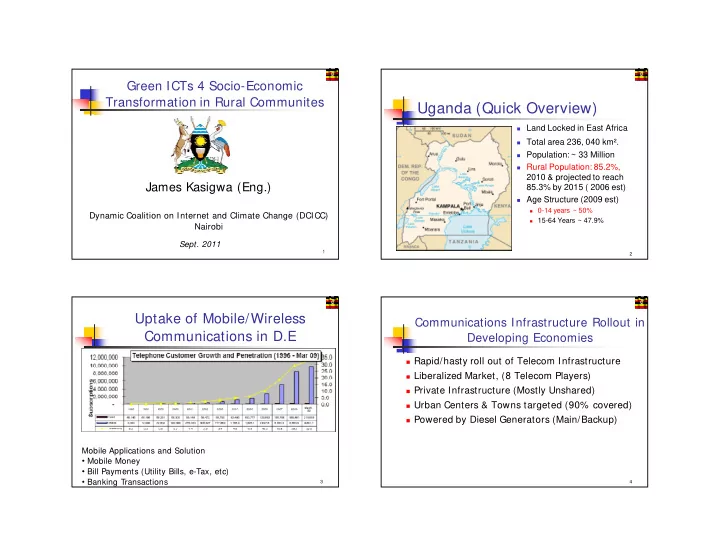

Green ICTs 4 Socio-Economic Transformation in Rural Communites Uganda (Quick Overview) Land Locked in East Africa Total area 236, 040 km². Population: ~ 33 Million Rural Population: 85.2%, 2010 & projected to reach James Kasigwa (Eng.) 85.3% by 2015 ( 2006 est) Age Structure (2009 est) 0-14 years ~ 50% Dynamic Coalition on Internet and Climate Change (DCICC) 15-64 Years ~ 47.9% Nairobi Sept. 2011 1 2 Uptake of Mobile/Wireless Communications Infrastructure Rollout in Communications in D.E Developing Economies Rapid/hasty roll out of Telecom Infrastructure Liberalized Market, (8 Telecom Players) Private Infrastructure (Mostly Unshared) Urban Centers & Towns targeted (90% covered) Powered by Diesel Generators (Main/Backup) Mobile Applications and Solution • Mobile Money • Bill Payments (Utility Bills, e-Tax, etc) • Banking Transactions 3 4
Lack of Infrastructure (ICT & Energy) Unsustainable Development in Rural Communities ICT (Digital Economy) Over 3000 BTS sites running on fossil generators Access & Connectivity (Backhaul, and Last Mile) (either as main or backup power source) Certainty and Payment (Cyber Laws, Payment means) 1200 liters of Diesel per month per BTS, making Logistical (Postal, and currier) over (3.6 Million liters per month). Energy The Generator Power rating 4 times the load ( Total Electricity installed 380MW operating 10-25% load, 3KVA running a 32 KVA) Hydro is 250MW of the 3000MW potential (Less than 10%) 5% of the population are connected to the National Grid (1% in rural) E-Waste Management in DCs Source of Energy Biomass 92%, Petroleum 6%, Electricity 2% 5 6 Target Group (Rural Populace) Challenges in Rural Areas (Developing Countries) Telecos in Rural Areas Rural Areas Low income (ARPU) Lack of Infrastructure (Power, etc) High CAPEX for Renewable energy Low Income (ARPU) No Infrastructure Safety No Relevant Services, No Relevant Services, No Relevant Content No Relevant Content Costly, polluting, unhealthy, and unsafe, 7 8
Model for Socio-Economic Benefits to the Environment Transformation Thru Green ICTs • Land for t he Green ICT Infrastructure • Renewable Energy plants, Direct Reduction in GHG emissions • Securit y for BTS sit e • Inst all t he Shared ICT infrast ructure • Maint enance personnel (Science (Tripple Play) Teacher) • Common Back Bone (Inter/ National) • Tele-center Resource Management connectivit y • Know ledge Sharing and Transfer • Relevant Content Development Clean Development Mechanism to Rural Communities • Relevant Service Development • ICT Capacit y Building in DCs Rural Comm. & Rural Institutions E-Waste Management Scheme Electrification Dev’t (School)/Communities Provides (Schemes) Automatic Weather Station (Early warning System, Disaster, Metrology data) Infrastructure Sharing (Energy Savings & Sceneries) Environment & Climate Change ICT service Providers (Schemes) Indirect GHG emissions reduction (Smart Technology) • Clean Development Mechanism • ICT Services and products • E-Wast e Management Center • Int ernet, Transport (Reduced Travels through e-services), • Collect ion center , Recycle and • Bat t ery Charging, reuse and proper disposal • F axing, Phot ocopy, • Aut omat ic Weather Stations • Public t elephones, • Early Warning Syst ems • TV and Film Renewable Energy promotion, • ICTs in Disast er/ Emergency • Corporat e Social Responsibilit y (CSR) • Met rology Center (Sensor Networks) 9 10 Benefits (National Level) Benefits (ICT Service Providers) Affordable & Equitably Access to relevant ICT Lower Total Cost of Ownership (CAPEX, Fuel, products & Services operational, security and land costs) Employment &Business opportunities Increased revenues and profits New skills & Capacity Development Increased coverage & competitive advantage Participation in the Digital Economy & Information Corporate Social Responsibility (capacity building, Society businesses, and services) Socio-economic Transformation (Health, Education Benefiting from rural communication schemes (Use of alternative energies Vs kerosene) Facilitates achieving the Millennium Development Goals (MDGS) 11 12
Outlook for Green ICT in Uganda Conclusion Multi-Sector ICT & Climate Change Committee Development of relevant Policies, regulations and ICT should clean up its act and all standards (E-Waste, Telecom) the other sectors can ride on its International Community participation (GEF, CDM) success and potential to achieve Pilot Project (10 sites for fast 2years, scale up) sustainable development National/Regions Green ICT Research Institute Infrastructure to support the Digital Economy Awareness Campaign & Capacity Building 13 14 Merci Beaucoup!!! james.kasigwa@ict.go.ug 15
Recommend
More recommend